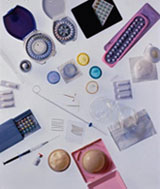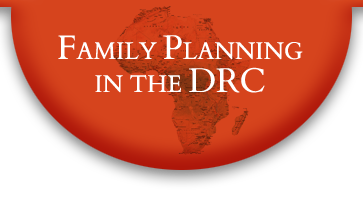Contraceptive Logistics
Back to CommoditiesORGANIZATIONS THAT PROCURE AND DISTRIBUTE CONTRACEPTIVE COMMODITIES FOR THE DRC
Three organizations procure most of the contraception distributed in the DRC: USAID, UNFPA, and (to a much lesser extent) ABEF/IPPF. These donors provide contraceptives free of charge to their own projects to distribute to the health zones (in the case of USAID) and to local health zones (in the case of UNFPA) for distribution to health structures in their catchment areas.
The contraceptive procurement activities of USAID and UNFPA reach an estimated 130 health zones in the DRC – of the total of 516 health zones. Although most major cities have fair access to contraception, many rural health zones are not covered by current programs.
 Although contraceptives are included in the list of Essential
Medications for the DRC, to date they have been treated
separately in terms of procurement, warehousing, and
distribution. According to the Strategic Plan of Reproductive
Security of the DRC 2008-2012, created with support from the
USAID-funded DELIVER Project (no longer working in the DRC)
and UNFPA, PNSR is responsible for building the
institutional capacity of the National Program for Supplying
Essential Drugs (PNAM) to provide contraceptive products to
all health zones. However, given that this project was proven
to be non-functional, currently several donors (notably
USAID and UNFPA) provide support to the DRC in procuring
and distributing FP commodities. Therefore, procuring
and distributing FP commodities, as well as other health
commodities, remain challenging due to weak information
and transportation systems. The system of contraceptive procurement
in the DRC has not succeeded in securing “The Six Rights of
Logistics,” including having the RIGHT goods in the RIGHT
quantities, in the RIGHT condition delivered to the RIGHT
place, at the RIGHT time, and for the RIGHT cost.
Although contraceptives are included in the list of Essential
Medications for the DRC, to date they have been treated
separately in terms of procurement, warehousing, and
distribution. According to the Strategic Plan of Reproductive
Security of the DRC 2008-2012, created with support from the
USAID-funded DELIVER Project (no longer working in the DRC)
and UNFPA, PNSR is responsible for building the
institutional capacity of the National Program for Supplying
Essential Drugs (PNAM) to provide contraceptive products to
all health zones. However, given that this project was proven
to be non-functional, currently several donors (notably
USAID and UNFPA) provide support to the DRC in procuring
and distributing FP commodities. Therefore, procuring
and distributing FP commodities, as well as other health
commodities, remain challenging due to weak information
and transportation systems. The system of contraceptive procurement
in the DRC has not succeeded in securing “The Six Rights of
Logistics,” including having the RIGHT goods in the RIGHT
quantities, in the RIGHT condition delivered to the RIGHT
place, at the RIGHT time, and for the RIGHT cost.
In the case of UNFPA, contraceptives distributed in the country are procured by the Procurement Service Branch (PSB) in Copenhagen and shipped into the country. According to the Strategic Plan of Reproductive Health Product Security of the DRC 2008-2012, initiated by the Ministry of Health through PNSR and with financial support from UNFPA, PNSR is responsible for the coordination of the Commodity Security Program in the country. PNAM (National Drug Supply Program) is responsible for strengthening the capacity of the national supply chain.
FORECASTING
Accurately forecasting the volume and types of contraceptives needed to meet the demand for contraception requires detailed information on existing stocks, dates of expiration, volume of contraception used in recent periods (based on program statistics), and expectations for any possible change in demand. Under the best of cases, this type of information may be hard to obtain. In a country with weak information systems, it is difficult to apply state-of-the-art forecasting tools.
USAID bases its forecasting on several factors: reports on the volume of contraceptives distributed in the programs it supports in four provinces (80 health zones), and information provided by the FP clinic/pharmacy network disseminated in the urban cities throughout the country.
UNFPA bases its forecasting on the size of the population in 56 health zones for which it currently procures contraceptives.
WAREHOUSING AND DISTRIBUTION OF COMMODITIES

There is no central warehouse where contraceptives are stored. When USAID receives its contraceptive shipments, it initially stores them in the warehouses of implementing partners in Kinshasa (PSI & MSH/PROSANI), then sends these supplies out to the USAID-funded programs and local entities that will distribute them. UNFPA also warehouses its shipments temporarily in Kinshasa, although they no longer have their own warehouses since 2011, and then delivers them directly to the health zones it supports.
One criticism of the current system is that the recipients of these shipments may not be adequately trained in family planning service delivery. Thus, the mere presence of contraceptive commodities does not necessarily translate into (1) distribution to interested clients, or (2) contraceptive use among the local population.
Because of the difficulty of estimating demand and tracking distribution of commodities through the system, projects and health zones may find themselves with stockouts on one or more contraceptive methods and a surplus of another, including products that have expired. Health zones have complained about receiving contraceptives on the verge of expiration, which represents another inefficiency in the system.
The following table shows the distribution chain once contraceptives arrive in the country for the two major donors: USAID and UNFPA.
Distribution Chain of Contraceptives
| Financial Source | Distribution Agency | First Point of Delivery | Second Point of Delivery | Third Point of Delivery | Fourth Point of Delivery |
|---|---|---|---|---|---|
| UNFPA | UNFPA | CDR Kinshasa
or Gome |
UNFPA Province Warehouses | Health Zone Central Bureaus | Health Centers
General Hospital |
| USAID | ASF | ASF Kinshasa Warehouse | ASF Province Warehouses | Private Pharmacies | |
| USAID | ASF | ASF Kinshasa Warehouse | ASF Province Warehouses | Maternity Centers
Health Centers General Hospital |
Relais Communautaires |
Distribution of Norlevo and Aleze 2015-2016
| Method | USAID | UNFPA | DKT |
|---|---|---|---|
| Norlevo | 23,000 | 130,000 | |
| Aleze | 200,000 |
Distribution of Contraceptives from UNFPA and USAID in DRC in 2010
Injectables
| Method | Units | UNFPA | USAID |
|---|---|---|---|
| Depo-Provera | Dose | 4 450 | 40 000 |
| Noristerat | Ampoule | 271 200 |
Oral Contraceptives
| Method | Units | UNFPA | USAID |
|---|---|---|---|
| Lo Femenal | Cycle | 32 900 | |
| Microgynon | Cycle | 1 902 402 | 411 840 |
| Microlut | 225 360 | ||
| Ovrette | Cycle | 400 | 400 |
Condoms
| Method | Units | UNFPA | USAID |
|---|---|---|---|
| Male Condom | Piece | 29 803 968 | 25 003 000 |
| Female Condom | Piece | 384 000 |
IUD
| Method | Units | UNFPA | USAID |
|---|---|---|---|
| Copper T 380A | Piece | 31 000 |
Implant
| Method | Units | UNFPA | USAID |
|---|---|---|---|
| Jadelle | Piece | 23 340 | 5 000 |
Emergency Contraceptive
| Method | Units | UNFPA | USAID |
|---|---|---|---|
| Postnor | Cycle | 50 000 | |
| Pregnon | Cycle | 1 460 |
Standard Days Method
| Method | Units | UNFPA | USAID |
|---|---|---|---|
| Cycle Beads | Necklace | 500,000 |


ACCOUNTING FOR THE FLOW OF PRODUCTS THROUGH THE SYSTEM
Both USAID and UNFPA track the shipment of supplies to the projects or health zones that receive them. However, the flow of information back from these entities regarding the distribution of the product to the beneficiary population is very uneven. Certain USAID-funded programs routinely provide service statistics on the amount of each contraceptive distributed to members of the target population by health zone (e.g., most USAID-funded projects). In contrast, UNFPA has had less success in obtaining records (e.g., service statistics on the distribution of contraceptives to the target population) in the health zones it supports. (See more on this topic under “ Information.”)
